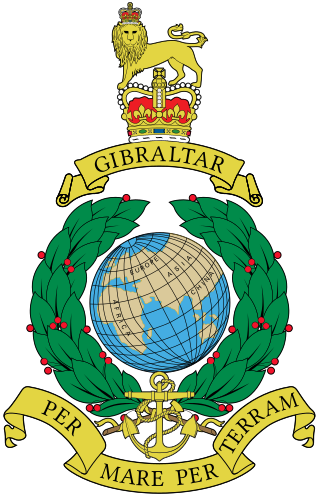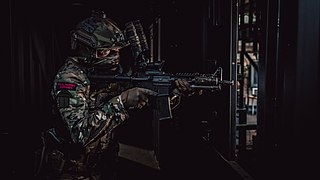
The Corps of Royal Marines (RM), today comprising the Royal Marines Commandos and the Royal Marines Band Service, provide the United Kingdom's amphibious commando force and naval musicians. They form the United Kingdom's special operations-capable commando force, amphibious light infantry, and one of the five fighting arms of the Royal Navy. The Royal Marines trace their origins back to the formation of the "Duke of York and Albany's maritime regiment of Foot" on 28 October 1664, and can trace their commando origins to the 3rd Special Service Brigade, now known as 3 Commando Brigade, which was formed on 14 February 1942, during the Second World War. The Corps also provides the Naval Musicians.

The Albion-class landing platform dock is a class of amphibious warfare ship in service with the Royal Navy. The class consists of two vessels, HMS Albion and HMS Bulwark, ordered in 1996 to replace the ageing Fearless class. Both ships were built by BAE Systems Marine at the former Vickers Shipbuilding and Engineering yard in Barrow-in-Furness. Albion was commissioned in 2003 and Bulwark in 2004. Each of the ships has a crew of 325 and can accommodate up to 405 troops. Thirty-one large trucks and thirty-six smaller vehicles and main battle tanks can be carried inside the vehicle deck. To disembark troops and vehicles, the vessels are equipped with eight landing craft.

RFA Cardigan Bay is a Bay-class landing ship dock of the Royal Fleet Auxiliary (RFA). Built by BAE Systems, the ship was dedicated into the RFA at the end of 2006.

Landing craft are small and medium seagoing watercraft, such as boats and barges, used to convey a landing force from the sea to the shore during an amphibious assault. The term excludes landing ships, which are larger. Production of landing craft peaked during World War II, with a significant number of different designs produced in large quantities by the United Kingdom and United States.

Future planning of the Royal Navy's capabilities is set through periodic Defence Reviews carried out by the British Government. The Royal Navy's role in the 2020s, and beyond, is outlined in the 2021 defence white paper, which was published on 22 March 2021. The white paper is one component of the Integrated Review of Security, Defence, Development and Foreign Policy, titled as Global Britain in a Competitive Age which was published on 16 March 2021.

Standing Royal Navy deployments is a list of operations and commitments undertaken by the United Kingdom's Royal Navy on a worldwide basis. The following list details these commitments and deployments sorted by region and in alphabetical order. Routine deployments made by the Navy's nuclear-powered submarines and their location of operations is classified.

A Landing Craft Utility (LCU) is a type of boat used by amphibious forces to transport equipment and troops to the shore. They are capable of transporting tracked or wheeled vehicles and troops from amphibious assault ships to beachheads or piers.

His Majesty's Naval Service is the United Kingdom's naval warfare and maritime service. It consists of the Royal Navy, Royal Marines, Royal Fleet Auxiliary, Royal Naval Reserve, Royal Marines Reserve and Naval Careers Service. The term Naval Service should be distinguished from the "UK Naval Services", which consist of the Naval Service and the Merchant Navy. The Naval Service as a whole falls under the command of the Navy Board, which is headed by the First Sea Lord. This position is currently held by Admiral Sir Ben Key. The Defence Council delegates administration of the Naval Service to the Admiralty Board, chaired by the Secretary of State for Defence.

The Gibraltar Squadron is a unit of the British Royal Navy. It is the only seagoing Royal Naval unit based in Gibraltar, attached to British Forces Gibraltar. It currently includes two Cutlass-class fast patrol boats with a maximum speed of up to 41-knots. The first new vessel of this class, HMS Cutlass, arrived in Gibraltar in November 2021, followed by the second vessel, HMS Dagger, in March 2022. The squadron also uses three Pacific 24 rigid-hulled inflatable boats, crewed by a team of 26 people and deploys one diving support boat. The 2021 defence white paper indicated that henceforth, one River-class offshore patrol vessel, HMS Trent, would also be permanently based in Gibraltar for operations in the Mediterranean and in the Gulf of Guinea.

An amphibious warfare ship is an amphibious vehicle warship employed to land and support ground forces, such as marines, on enemy territory during an amphibious assault.

The Joint Expeditionary Force (Maritime) (or JEF(M)) (formerly the Response Force Task Group (RFTG), and prior to that the Joint Rapid Reaction Force (JRRF)), is the Royal Navy's contribution to the UK Joint Expeditionary Force (JEF) maintained at very high-readiness and available at short notice to respond to unexpected global events. In addition to the Royal Navy and the Royal Marines, the JEF(M) also includes elements of the British Army and the Royal Air Force. While it is primarily poised to conduct war-fighting or strike operations, the JEF(M) is capable of undertaking a diverse range of activities such as evacuation operations, disaster relief or humanitarian aid.
Royal Marines recruit training is the longest basic modern infantry training programme of any Commonwealth, or North Atlantic Treaty Organization (NATO) combat troops. The Royal Marines are the only part of the British Armed Forces where officers and other ranks are trained at the same location, the Commando Training Centre Royal Marines (CTCRM) at Lympstone, Devon. Much of the basic training is carried out on the rugged terrain of Dartmoor and Woodbury Common with a significant proportion taking place at night.

This is a list of Active Royal Navy weapon systems.

The Landing Craft Vehicle Personnel (LCVP) is a versatile amphibious landing craft designed to transport troops or armoured vehicles from ship to shore during amphibious landings. The designation was first used in British service for the LCVP Mk2s introduced with the two Fearless class amphibious transport docks, the role having previously been carried out by the Landing Craft Assault developed during the Second World War. They are manned and operated by 1 Assault Group Royal Marines.

A Landing Craft Vehicle Personnel or Landing Craft, Vehicle, Personnel (LCVP) is any of a variety of amphibious landing craft designed to transport troops or armoured vehicles from ship to shore during amphibious landings.

The Offshore Raiding Craft (ORC) is a small, fast boat used by the Royal Marines for troop insertion, and patrols. The ORC is primarily used when undertaking strategic raiding missions, where speed and covertness is desired. However, it is equally capable when conducting larger scale amphibious operations alongside the larger and more traditional LCACs, LCUs and LCVPs.

The Inflatable Raiding Craft (IRC) is a series of fast raiding and assault craft in service with the Royal Navy (incl. the Royal Marines and the Special Boat Service). Despite being among the smallest of the amphibious craft, the IRC is one of the most widely used due to its mobility and versatility. The IRC is essentially a type of inflatable boat, the American equivalent is the Combat Rubber Raiding Craft.

The Landing Craft Air Cushion (Light), or LCAC(L), is a small amphibious hovercraft able to transverse both land and water. Like all amphibious landing craft in the Royal Navy, they are operated by the Royal Marines to transport troops or equipment from ship to shore during an amphibious landing.

The Future Commando Force (FCF) is an in-progress modernisation programme and model of the future role and operations of the Royal Marines. The FCF essentially retasks 40 Commando and 45 Commando with implementing the infantry component of two Littoral Response Groups (LRGs), though other units from 3 Commando Brigade are also included in the composition of LRGs, as well as changing the role and operations of the Royal Marines and the equipment and tactics they use. The FCF concept was created before 2019, when the first exercises and experiments with the FCF began. It was reinforced in the Defence in a Competitive Age command paper, which followed the Integrated Review. It describes the Royal Marines as a forward-deployed maritime special operations/special operations capable force which will work with greater agility and autonomy, and in smaller teams that specialise in raids within littoral zones, and operations within grey zones and other special operations to relieve and complement United Kingdom Special Forces (UKSF). The emphasis on the littoral role of the Royal Marines strongly links the FCF to the Littoral Strike concept, which is being developed and implemented by the LRGs. The FCF is also strongly linked to the "Autonomous Advanced Force" concept by its emphasis on leveraging new technologies to augment commandos on operations. A series of exercises from 2019–present have been key to developing the FCF, chiefly with experimentation.














